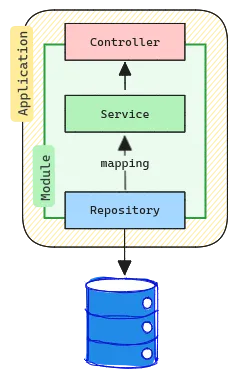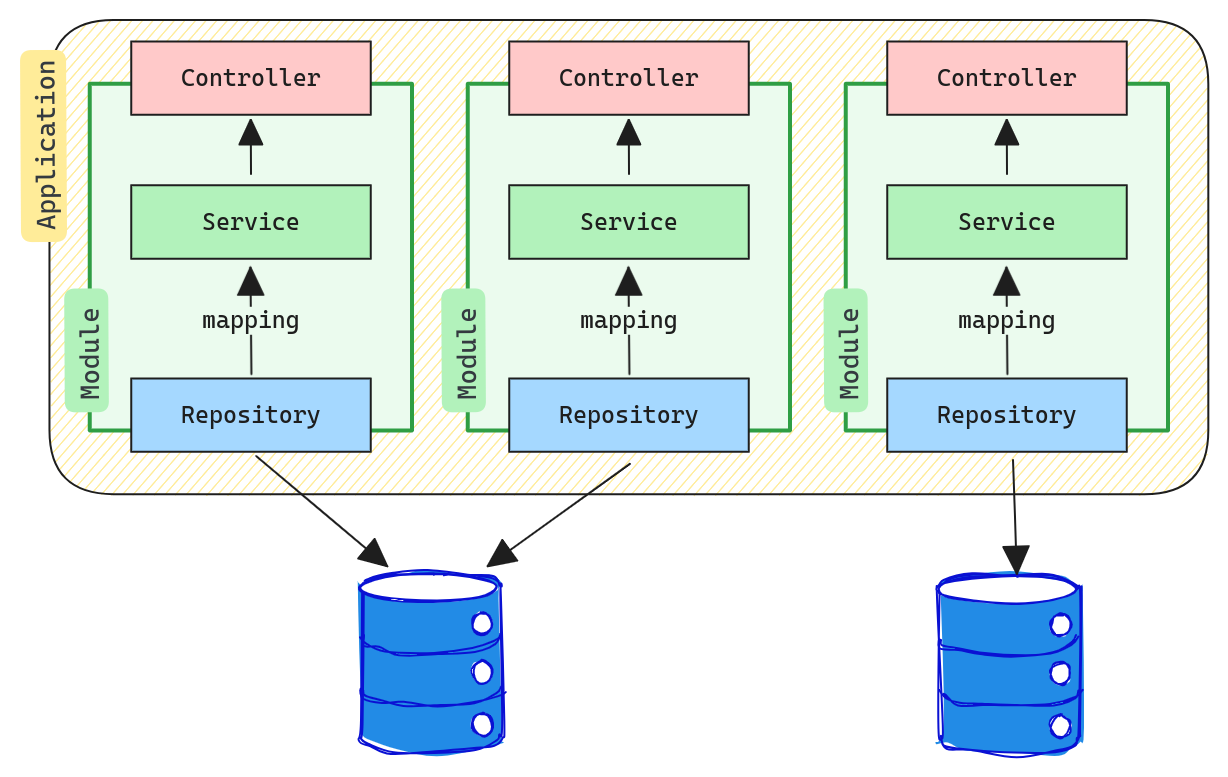Architecture Style: Modulith (vs. Microservices)
Modulith architecture is a style of software design that emphasizes modularity within a monolithic application. It aims to combine the simplicity and straightforward deployment model of a monolithic architecture with the modularity and maintainability typically associated with microservices.
In a modulith, the application is structured as a collection of loosely coupled modules, each encapsulating a specific business capability or domain. These modules interact with each other through well-defined interfaces, yet they are deployed as a single unit, similar to a traditional monolithic application.
In a modulith, the application is structured as a collection of loosely coupled modules, each encapsulating a specific business capability or domain.
So, a monolithic application would look like this:

So a modulithic application would look like this:

Benefits
Enhanced Modularity
Moduliths promote a clean separation of concerns by organizing code into distinct modules. This separation enhances the maintainability and understandability of the codebase, making it easier for teams to manage large and complex applications.
Simplified Deployment
Unlike microservices, which require complex orchestration for deployment, moduliths are deployed as a single unit. This simplifies the deployment process and reduces the operational overhead associated with managing multiple services.
No Network Overhead
Moduliths operate without the additional network overhead typical in microservices. This is due to their internal module communication being in-process, eliminating the latency and complexity associated with network calls between separate services.
Fit Well With a DDD Approach
Modulith architecture aligns well with Domain-Driven Design (DDD). It naturally supports bounded contexts by allowing each domain model to be encapsulated within its own module, fostering a clear domain model and business logic separation.
Trade-Offs
Potential for Tight Coupling
While moduliths aim for loose coupling between modules, there’s a risk of inadvertently introducing tight coupling, which can lead to challenges in module isolation and independent scaling. Even with modular separation, coupling is not guaranteed as it is with microservices.
Complexity in Scaling
Moduliths may not scale as efficiently as microservices in certain scenarios. Scaling a modulith often means scaling the entire application rather than individual components, which can be less efficient.
Technology Stack Limitations
In a modulith, the entire application typically shares a common technology stack. This can limit the flexibility to use different technologies or programming languages best suited for specific modules, as often done in a microservices architecture.
Spof
Todo
Modulith or Microservices
When deciding between modulith and microservices architectures, the key factor is the level of coupling you’re comfortable with.
More coupling simplifies maintenance but comes with trade-offs, like scalability complexity.
For instance, if part of your application faces heavy loads distinct from the rest, a microservices approach could allow for targeted scaling. Choosing different frameworks or languages also justifies using microservices.
However, for isolating domains within an app, like products and clients, a modulith can be effective. It keeps these domains together for versioning and lifecycle management, simplifying CI/CD and database maintenance while still maintaining a manageable level of coupling through modularization.
Ultimately, the best choice depends on your specific needs, and often, a combination of both approaches works well.
Often, a combination of both approaches works well.
Spring Modulith Implementation
Overview
Spring Modulith is an approach for implementing the modulith architecture using the Spring framework. It is designed to help developers structure their Spring applications in a modular way, following the principles of modulith architecture.

Key Features
- Module Definition: Spring Modulith allows defining modules within a Spring application. Each module encapsulates its own business logic, data access, and Spring components.
- Inter-module Communication: It provides mechanisms for modules to communicate with each other through events or shared interfaces, maintaining loose coupling. It also could be done using event between modules.
Note: If you make an interaction between modules that is not correct, the compilation will not fail; you need to implement a test that will fail to prevent that kind of usage. This is based on the ArchUnit tests.
- Module Isolation: While each module is part of the same monolithic application, Spring Modulith enforces boundaries to prevent unintended dependencies and tight coupling.
- Testing and Development: Spring Modulith supports testing at the module level, enabling developers to write and run tests for individual modules without the need for the entire application context.
More information here.
Conclusion
In conclusion, the Modulith architecture offers a balanced approach to application design, blending monolithic simplicity with microservices’ modularity. It suits scenarios where domain isolation within a single application is required.
While moduliths enhance modularity, reduce deployment complexity, and align well with Domain-Driven Design, they face challenges in scaling and technology flexibility.
The decision between moduliths and microservices hinges on the acceptable level of coupling, with a hybrid approach often being effective.
Spring Modulith specifically caters to the Spring framework, facilitating module definition, inter-module communication, and isolation while supporting effective testing strategies.

